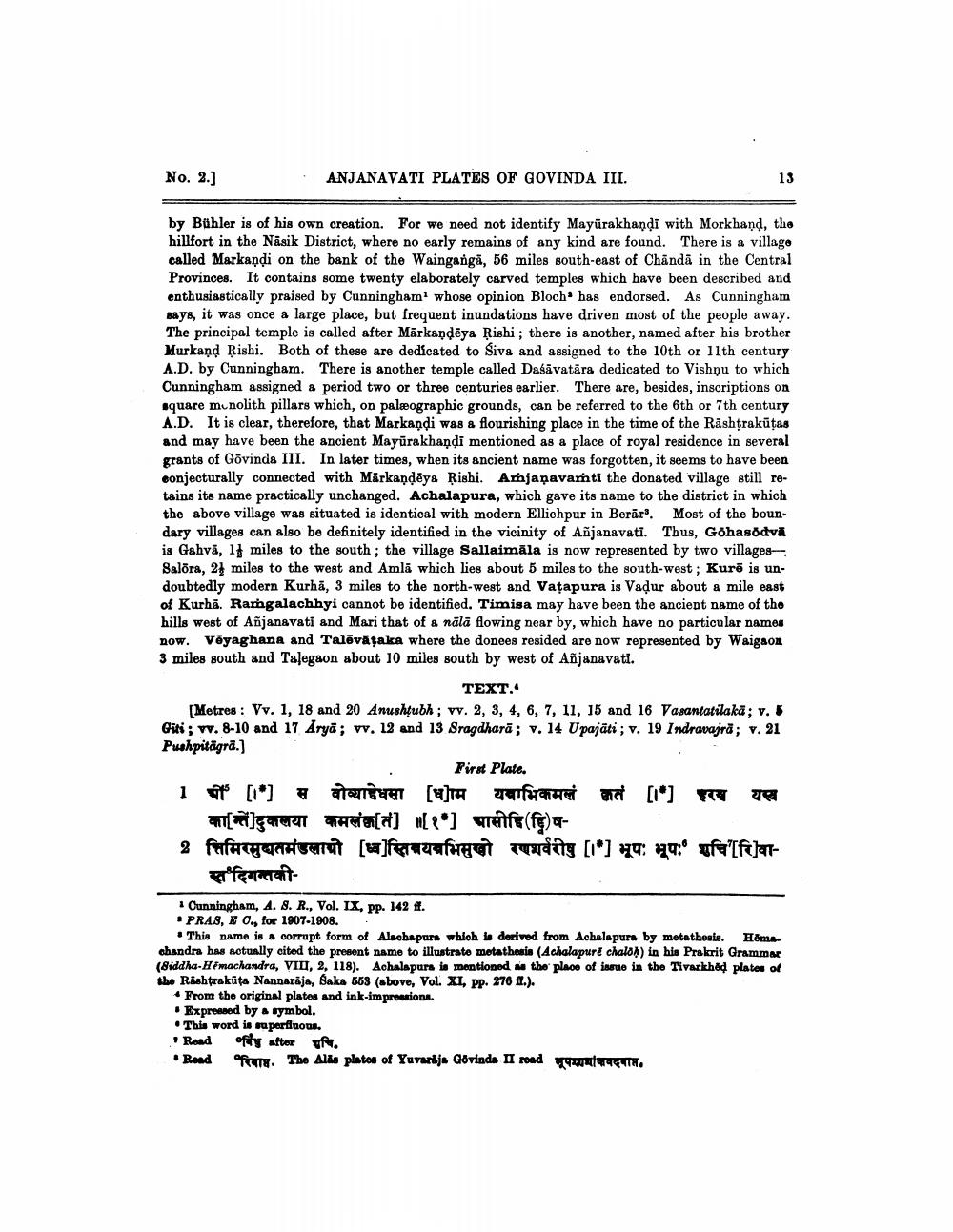________________
No. 2.)
ANJANAVATI PLATES OF GOVINDA III.
13
by Bühler is of his own creation. For we need not identify Mayūrakhandi with Morkhand, the hillfort in the Näsik District, where no early remains of any kind are found. There is a village called Markandi on the bank of the Waingangā, 56 miles south-east of Chăndă in the Central Provinces. It contains some twenty elaborately carved temples which have been described and enthusiastically praised by Cunningham whose opinion Bloch has endorsed. As Cunningham says, it was once a large place, but frequent inundations have driven most of the people away. The principal temple is called after Mārkandēya Rishi ; there is another, named after his brother Murkand Rishi. Both of these are dedicated to Siva and assigned to the 10th or 11th century A.D. by Cunningham. There is another temple called Daśāvatāra dedicated to Vishņu to which Cunningham assigned a period two or three centuries earlier. There are, besides, inscriptions on square munolith pillars which, on palæographic grounds, can be referred to the 6th or 7th century A.D. It is clear, therefore, that Markaņdi was a flourishing place in the time of the Rashtrakūtas and may have been the ancient Mayūrakhandi mentioned as a place of royal residence in several grants of Govinda III. In later times, when its ancient name was forgotten, it seems to have been eonjecturally connected with Mārkandēya Rishi. Amjanavamti the donated village still retains its name practically unchanged. Achalapura, which gave its name to the district in which the above village was situated is identical with modern Ellichpur in Berār'. Most of the boundary villages can also be definitely identified in the vicinity of Añjanavati. Thus, Gohasodva is Gahvā, 1 miles to the south; the village Sallaimāla is now represented by two villagesSalora, 2 miles to the west and Amlā which lies about 5 miles to the south-west ; Kurē is undoubtedly modern Kurhā, 3 miles to the north-west and Vațapura is Vadur about a mile east of Kurha. Ramgalachhyi cannot be identified. Timisa may have been the ancient name of the hills west of Añjanavati and Mari that of a nālā flowing near by, which have no particular names now. Vēyaghana and Talēvāțaka where the donees resided are now represented by Waigaon 3 miles south and Talegaon about 10 miles south by west of Añjanavati.
TEXT. [Metres : Vv. 1, 18 and 20 Anushfubh ; vv. 2, 3, 4, 6, 7, 11, 15 and 16 Vasantatilaka; v. 5 Giti; w. 8-10 and 17 Aryā; v. 12 and 13 Sragdharā; v. 14 Upajāti; v. 19 Indravajra; v. 21 Pushpitägra.]
. First Plate. i t [1] # aga []TH RH [*] HT te
PT[ migranteren heina] [*] weitfe(fyo2 fafaty Heat [w]feruafi ruuang [*] 0:0:f'[fija
स्त दिगन्तकी
* Cunningham, A. 8. R., Vol. IX, pp. 142 ff. • PRAS, E 0., for 1907-1908. .
• This name is & corrupt form of Alaoba pars whloh is derived from Achslapura by metatheais. Hôma. chandra has actually cited the present name to illustrate metathesis (Achalapurl chalo) in his Prakrit Grammar (Siddha-Himachandra, VIII, 2, 118). Achalapurs is mentioned as the place of issue in the Tivarkhód plates of the Rashtrakūta Nannaraja, Saka 563 (above, Vol. XI, pp. 276 ft.).
• From the original plates and ink-impressions. • Expressed by a symbol. • This word is raperfluous. .. Read ofty after of • Road . The Alle platos of Yuvarija Govinda II road www .




